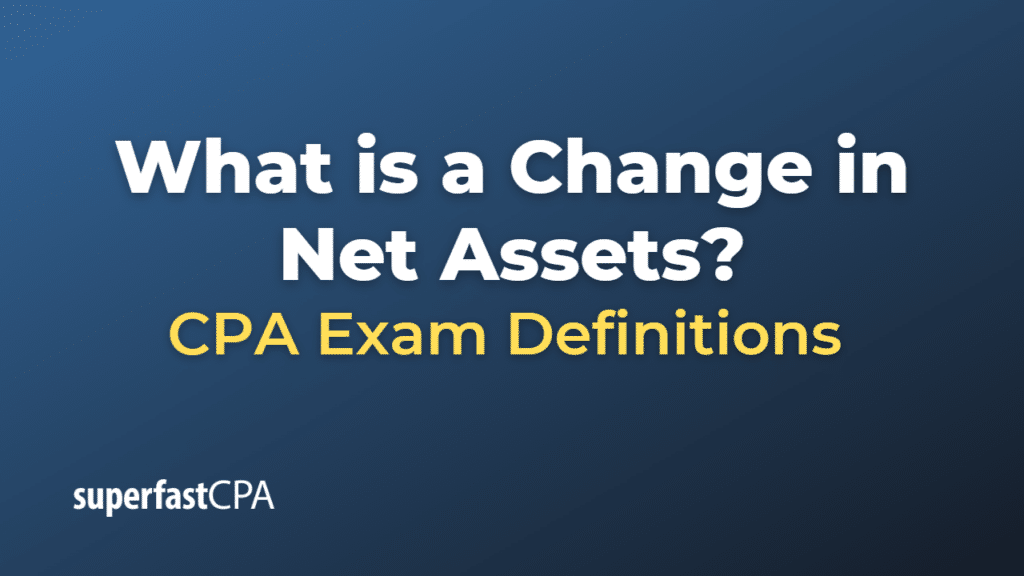Change in Net Assets
A change in net assets refers to the difference between an entity’s net assets at the beginning of a financial period and its net assets at the end of the same period. Net assets, also known as owners’ equity, shareholders’ equity, or stockholders’ equity for corporations, represent the residual interest in an organization’s assets after deducting liabilities. In other words, net assets are the value of the assets that belong to the owners of the organization after all obligations have been settled.
The change in net assets can result from various factors, including:
- Operating activities: Profits or losses generated from an organization’s core business operations, such as sales revenue, cost of goods sold, and operating expenses, can cause a change in net assets. A net profit increases net assets, while a net loss decreases them.
- Non-operating activities: Gains or losses from non-operating activities, such as investment income, interest expense, or gains/losses from the sale of assets, can also impact net assets.
- Contributions and distributions: For non-profit organizations, donations, grants, or other contributions can increase net assets, while distributions to beneficiaries or program expenses can decrease net assets. For corporations, issuing new shares or paying dividends to shareholders can also affect net assets.
- Changes in accounting policies, estimates, or principles: Adjustments to financial statements due to changes in accounting policies, estimates, or principles can cause a change in net assets.
- Comprehensive income: This includes items that are not part of the net income reported in the income statement but affect the net assets directly. Examples include unrealized gains or losses on available-for-sale securities, foreign currency translation adjustments, and changes in the funded status of pension plans.
The change in net assets is an important measure of an organization’s financial performance and health, as it indicates the extent to which an organization’s assets have increased or decreased during a specific period. Monitoring the changes in net assets can help users of financial statements assess the organization’s ability to generate value for its owners, manage its resources efficiently, and meet its financial obligations.
Example of a Change in Net Assets
Let’s consider an example of a change in net assets for a small business during a financial year.
At the beginning of the financial year, the company has the following financial position:
- Total assets: $500,000
- Total liabilities: $300,000
- Net assets (owners’ equity): $200,000 (Total assets – Total liabilities)
During the financial year, the company experiences the following events:
- Operating activities: The company generates a net profit of $80,000 from its core business operations, such as sales revenue and operating expenses.
- Non-operating activities: The company receives $5,000 in dividend income from an investment in another company’s shares.
- Contributions and distributions: The company issues new shares and raises $50,000 in additional equity capital from investors. It also pays $20,000 in dividends to its shareholders.
- Comprehensive income: The company has unrealized gains of $10,000 on its available-for-sale securities.
At the end of the financial year, the company’s net assets will change as follows:
- Beginning net assets: $200,000
- Net profit from operating activities: +$80,000
- Dividend income from non-operating activities: +$5,000
- New share issuance: +$50,000
- Dividends paid to shareholders: -$20,000
- Unrealized gains on available-for-sale securities: +$10,000
The change in net assets for the financial year is: $80,000 (profit) + $5,000 (dividend income) + $50,000 (new shares) – $20,000 (dividends paid) + $10,000 (unrealized gains) = $125,000.
The ending net assets (owners’ equity) at the end of the financial year will be $325,000 ($200,000 beginning net assets + $125,000 change in net assets).
In this example, the change in net assets provides insight into the company’s financial performance during the year, showing an increase in the value of the business for its owners. This information can be useful for evaluating the company’s ability to generate value, manage its resources efficiently, and meet its financial obligations.













